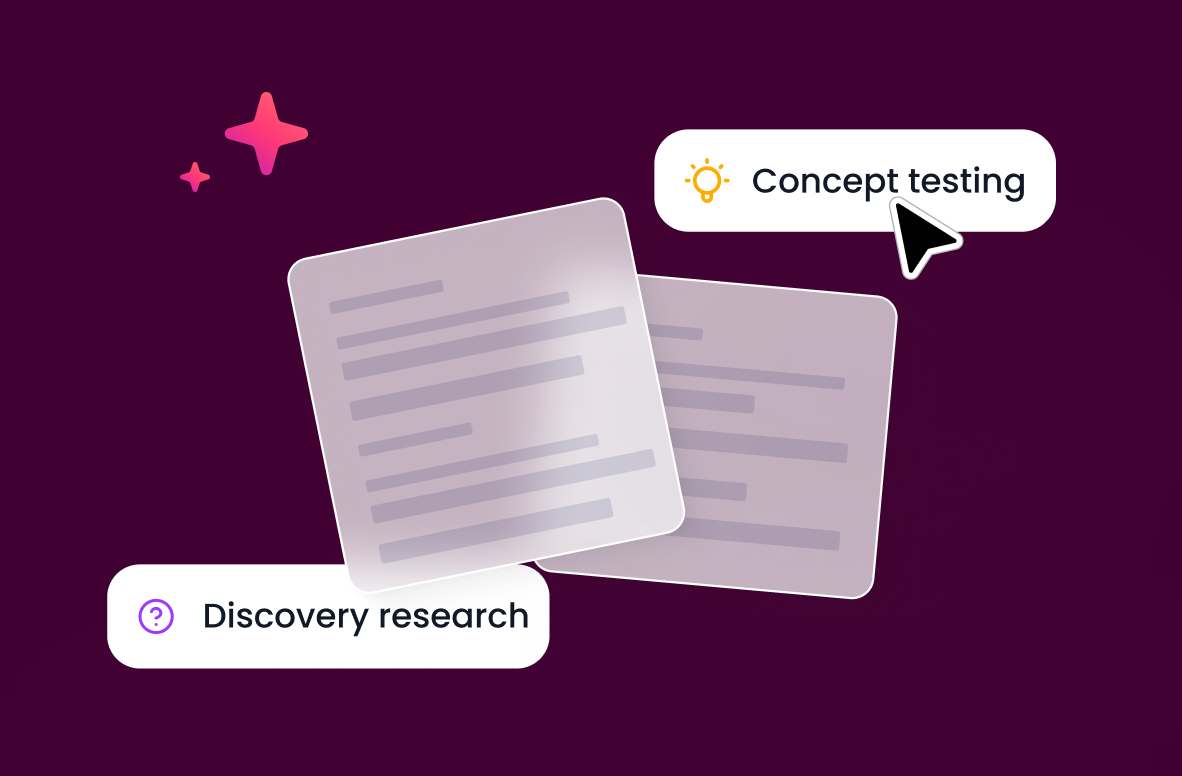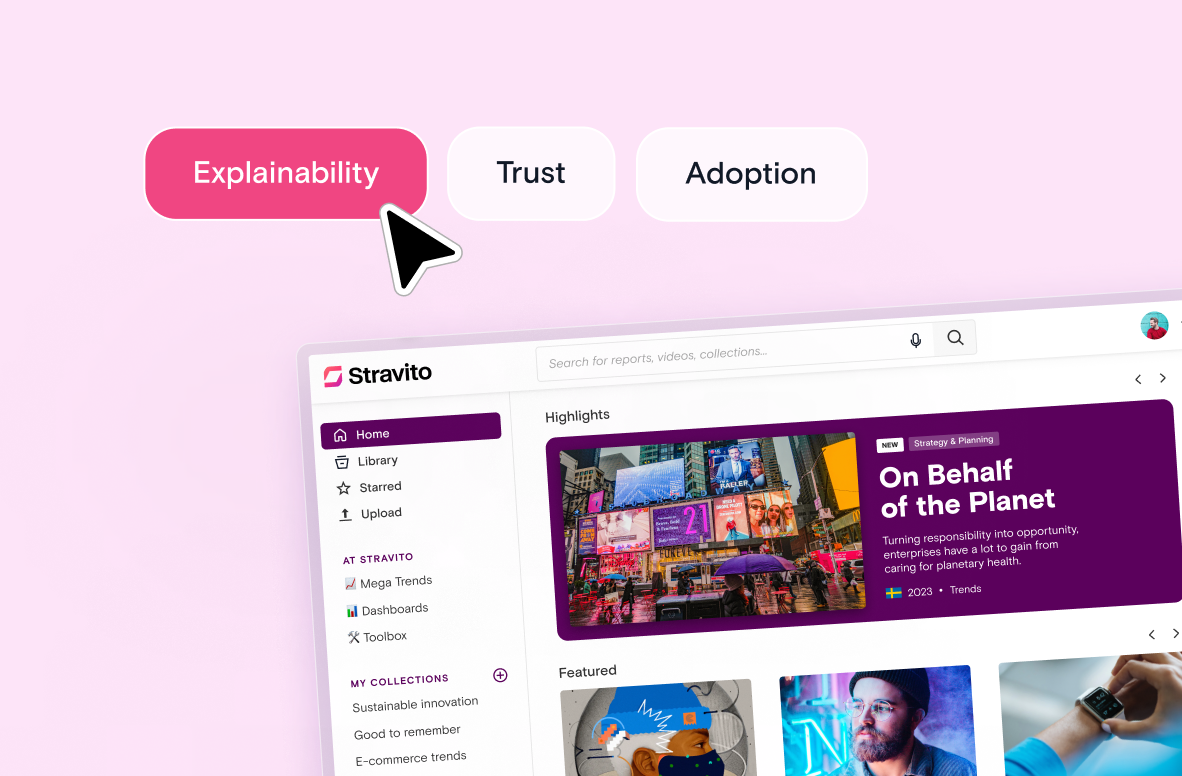TL;DR:
- Concept validation testing shows if your customers will choose your concept over what they already use.
- It helps your business prove market fit before your team invests in new products or campaigns.
- You’ll learn when to test, which concept testing methods to use, and how to run a clear concept validation process.
- The guide covers how to keep tests valid, reliable, and free from bias.
- You’ll also see how AI personas and AI knowledge management can help your teams move faster without losing human judgment.
You don’t need more research. You need better research.
Most enterprises test plenty of ideas but lack one system to connect results. Teams run studies in silos. Insights get lost in slides. Decisions slow down.
Concept validation testing changes that. It gives your teams one repeatable way to prove which ideas are worth building and which to leave behind.
Today, you’ll learn how to make that process consistent across markets and faster for your teams, with AI personas helping you explore and stress-test creative ideas early while keeping human validation in control.
Where does concept validation testing fit alongside discovery and usability research? Let's talk about it.
Concept validation vs discovery vs usability testing
Most teams run all three, but not always in the right order.
Each has a different goal and answers a different question about your customers. Knowing when to use each one keeps your research focused and your decisions faster.
|
Research Type |
When You Use It |
What It Answers |
Outcome |
|
Discovery research |
Early in the innovation or product development process |
What problems do your customers have? What jobs are they trying to get done? |
Clear opportunity areas and early hypotheses for your team to explore |
|
Concept validation testing |
Before a major investment or build |
Does the concept make sense? Is it believable, unique, and relevant enough for your customers to switch? |
A go, pivot, or no-go decision based on real evidence |
|
Usability testing |
After the concept is developed or prototyped |
Can customers use it easily and understand how it works? |
Concept validation testing sits in the middle of your research cycle, connecting the concept of validation in research with practical decisions.
Your team confirms what works before it becomes too costly to change. It also ensures concept testing validation aligns with how your customers think, not just what internal teams assume.
When your business gets this timing right, your insights flow naturally from discovery to launch. Each phase builds on the last, and your teams learn faster every time.
Now that you know where concept validation fits, let’s look at how to build a consistent, enterprise-ready process your teams can use across every market.
The enterprise concept validation framework and 5-step process
You don’t need a complex playbook to make concept validation research work at scale. You just need a process your teams can repeat and trust.
This five-step framework helps your business move from scattered tests to a shared system that creates reliable results and faster decisions.
Step 1: Define and align
Start by defining what your team wants to decide. Are you confirming product concepts, testing pricing, or refining your value proposition? Agree on clear success metrics such as purchase intent, uniqueness, and perceived value.
What to watch out for
Set your decision rules before you collect any data. It’s easy for teams to shift expectations once results arrive. Predefined thresholds make your outcomes fair, consistent, and defensible.
Step 2: Design the right test
Choose the testing methods that fit your goal.
- Monadic testing gives you a clean read since each participant sees one concept.
- Sequential monadic testing helps you test multiple concepts with the same group while keeping results balanced.
- Comparative testing highlights the relative appeal of different concepts.
- Protomonadic testing combines both approaches for deeper insights.
Blend qualitative research with quantitative research to get a full picture. Focus groups, in-depth interviews, and concept testing surveys uncover context behind the numbers.
This mix helps your team see why customers react the way they do and which product concepts have real market potential.
Our pro tip
Keep designs simple. Shorter surveys reduce respondent fatigue and limit external factors that can distort findings.
Step 3: Recruit and field
Find the right target audience for your study. Match quotas to your target market and include current users, competitor users, and new prospects.
What to watch out for
Monitor completion rates and data quality. If the test feels time-consuming, respondents disengage. Use mobile-friendly layouts and quick open-text prompts to gather feedback that feels natural.
Step 4: Analyze and decide
Once data collection is complete, focus on decisions, not dashboards.
Your teams can:
- Run data analysis that blends quantitative data with open-text themes.
- Identify patterns that reveal preferred concepts.
- Compare differences between markets to guide your next steps.
Our pro tip
Translate findings into clear next steps. Identify which ideas to advance, which to adjust, and which to drop. Turning insights into action creates the most value for your business and helps your teams guide product development decisions with confidence.
Step 5: Share and scale
Turn every project into a reusable asset. Store your materials, data collected, and results in one place so your teams can learn from each other instead of starting over.
How to get it right
For structure, use resources like how to create a knowledge base and knowledge management framework to keep everything organized and searchable. Over time, your organization will have a complete system for learning and reuse.
What you can expect to see
Teams begin to validate ideas faster, skip duplicate tests, and build a stronger link between research and final product performance.
A few best practices go a long way. Validate early while ideas are still flexible. Test both single and multiple concepts so you see what truly stands out. Then compare results to what actually launches to keep improving over time.
When this process becomes routine, your teams make faster, clearer decisions backed by evidence.
But what truly works? Let's take a closer look at the different concept testing methods and when to use each one.
Concept testing methods - what to use and when
Choosing the right approach is what makes concept validation work. Your business doesn’t need every method, just the ones that fit your goals, timeline, and target audience. Each testing method gives you a different view of how customers respond to product concepts, pricing, or messaging.
|
Method |
What it’s best for |
When to use it |
What to watch for |
|
Monadic testing |
Testing one concept per person for clean, unbiased results |
When you need a reliable read on a single concept’s performance |
Requires larger sample sizes but delivers stronger accuracy |
|
Sequential monadic testing |
Comparing multiple concepts with the same group |
When you have limited time or budget |
Randomize order to avoid bias and respondent fatigue |
|
Comparative testing |
Showing customers several concepts at once |
When you want to see relative appeal or preference |
Can be time-consuming if you test too many at once |
|
Protomonadic testing |
Mixing monadic and comparative approaches |
When you need both preference and validation in one round |
Keep stimuli consistent so results accurately reflect true choice |
|
Qualitative research (e.g., focus groups or interviews) |
Explores reactions and motivations behind concept scores. |
When you need deeper understanding of customer needs or emotions |
Works best alongside quantitative testing for added context |
|
Prototype testing |
Assessing early design or usability ideas |
When your concept is visual or functional |
Keep tests short to maintain attention and completion rates |
|
Pricing tests (PSM or conjoint) |
Understanding price sensitivity and trade-offs |
When you’re defining value and pricing strategy |
Combine with quantitative research for stronger insights |
Our pro tip:
Start small.
A single concept test or a few focus groups can surface valuable insights before you scale. Use short surveys to gather feedback and make early validation faster for your teams.
The most effective concept testing happens when qualitative and quantitative research work together.
You see what people say, what they choose, and why. That balance helps your business identify the right concepts faster and design stronger, more customer-driven products.
Now that you know which concept testing methods to use, let’s look at how to make your results reliable, valid, and ready for confident decisions.
Make it measurable - validity, reliability, and key metrics
Your concept validation research only works if the results are solid.
Validity and reliability make sure your data reflect what’s really happening with your customers, not what your teams hope to see.
What to measure
- Construct validity checks if you’re measuring the right things, like perceived value or uniqueness, instead of surface preferences.
- Internal validity ensures your test setup is sound. Randomize the order of concepts and keep variables consistent so your results stay fair.
- External validity tells you if your findings match the real world. Recruit participants who reflect your target market so your data applies outside the test.
- Reliability means results stay stable when you repeat the test. Run a small retest or compare markets to confirm patterns.
Your goal is to turn data collection into insight that drives confident decisions.
Combine quantitative research with open-ended feedback, both to see the “what” and explore the “why.” Consulting quantitative data along with qualitative themes builds a full picture your business can act on.
Blending automation with human judgment can strengthen your analysis, too.
Modern approaches like AI UX research show how your teams can scale testing and still capture the nuance behind customer reactions.
Our pro tip
Plan your analysis before you field the survey. Define how you’ll handle data analysis, factor analysis, and thresholds for success. This keeps your teams aligned and prevents subjective debates later.
The key metrics to track
- Purchase intent - would customers actually buy it?
- Believability and relevance - do they trust it and see value in it?
- Uniqueness and clarity - does it stand out and make sense quickly?
- Value for money and perceived value - does the price feel fair for what they get?
If your teams want to make these metrics part of everyday practice, it helps to organize them so that everyone can access and update them.
Resources like how to create a knowledge base and knowledge management framework show how your business can organize insights in one accessible place so validation results turn into shared learning, not one-off reports.
The best concept validation combines numbers and narrative into actionable data. Your business learns not just what performed well, but why it did, so every decision moves the next idea forward.
How can you scale this process globally and keep results comparable across every market?
Scaling validation globally
If your business runs research across markets, you know how hard it is to keep everything connected.
Each team uses its own tools, methods, and measures. The result is a pile of reports that don’t align and insights that never scale.
A global validation framework fixes that. It gives your insights teams a shared way to test ideas, compare results, and reuse what works.
That consistency turns validation into a global advantage, not just a local task.
What to focus on
- Global core, local flexibility. Build one shared structure for validation that keeps comparability across countries. Then let each market add local details like language, channels, or regulatory checks.
- Centralized evidence. Keep every concept, test, and result in one secure hub such as Stravito. When teams can find past results fast, they avoid re-testing the same ideas.
- Shared decision rules. Set global success thresholds for metrics like purchase intent and perceived value. Each region still has room to adapt, but the overall standard stays clear.
- Clear ownership. Assign a lead per category or market who ensures quality, manages updates, and keeps the data accurate.
When you align your global and local teams, validation becomes faster and more efficient. It also helps your business uncover market potential that might otherwise stay hidden.
Our pro tip
Share stories, not just numbers.
Our post sharing insights to fuel innovation shows how insights leaders connect research and innovation to spark better ideas across teams.
Use that same mindset when sharing results so your validation work inspires action, not just documentation.
The stronger your global setup, the easier it is to scale effective concept testing. Your teams start working as one network that learns together instead of in silos.
Now that you have consistency, the next leap is speed and collaboration. Here’s how Stravito and its AI personas help your teams test ideas early and refine them together.
3 Ways Stravito and AI Personas accelerate validation
Most validation work takes time. Collecting data, organizing findings, and creating summaries can slow momentum between markets. Stravito helps your business shorten that gap without cutting corners.
1. Faster, earlier learning
Use Stravito AI Personas to explore new ideas before you field a study. They let your teams stress-test creative directions, compare different concepts, and refine early hypotheses.
This kind of proof-of-concept validation helps you spot what resonates before you invest in larger research.
2. Smarter knowledge reuse
All your insights, product concepts, and validation results stay connected inside Stravito. That means your teams can:
- See what worked in other markets and adapt faster.
- Find and compare related studies in seconds.
- Summarize data collected across projects to uncover trends.
- Spot patterns that help your business make stronger, evidence-based decisions.
3. Human validation stays central
AI speeds up discovery, but your people bring the context. Stravito keeps synthetic and human insights side by side so your teams can compare, refine, and validate ideas with real participants.
That balance makes early validation faster while keeping reliability intact.
Our pro tip
Use the platform’s search and tagging features to find previous results that match your current question. You’ll gather feedback faster and avoid re-testing ideas that already have data behind them.
This is the same balance your teams can use to speed up validation without losing rigor.
When validation becomes connected, collaborative, and continuous, your teams move from isolated tests to shared progress. Each study builds on the last, and every decision gets smarter.
Build validation into how your business learns
Great ideas aren’t rare. Confident decisions are. Making validation a daily habit turns uncertainty into progress and progress into growth that your competitors will feel.
Here’s how to move forward:
-
Standardize your process. Align global and local teams around one validation framework so results stay consistent everywhere.
-
Blend automation and human insight. Use AI personas and tools like Stravito to speed up early exploration while keeping real validation grounded in people.
-
Turn validation into shared learning. Store results, thresholds, and benchmarks where everyone can access and reuse them.
Suggested reading
- AI, synthetic data, and the power of co-creation - how insights leaders use AI to explore early hypotheses while keeping humans firmly in control.
- The best customer insights tools - explore more platforms that help insights teams work faster and smarter.
To explore how your business can bring this workflow to life, request a Stravito demo.
FAQs
What’s the difference between concept validation testing and concept testing?
Concept validation testing confirms if your target audience would actually choose your idea over what they use today. Concept testing focuses more on reactions, what people like or notice. Validation connects those reactions to real business outcomes.
How is concept validation different from usability testing?
Validation happens earlier. It tests if your idea has value before you build it. Usability testing comes later and checks if people can use the final product easily. Both are essential parts of an effective concept testing process.
What methods should I use for early vs. late-stage validation?
In the early stages, use qualitative research like focus groups or in-depth interviews to explore perceptions and find friction. For later stages, add quantitative research such as monadic testing or comparative testing to confirm results with reliable data.
How do I adapt tests for multiple markets without losing comparability?
Keep your core measures, like purchase intent and perceived value, consistent everywhere. Then allow each region to localize visuals, language, or claims. Using a shared knowledge system like Stravito helps your insights teams track versions and compare results.
How do I connect validation scores to launch decisions?
Predefine what success looks like before you field a study. For example, move forward only if purchase intent improves by a set percentage or if your concept outperforms current options. Linking those metrics directly to decision rules makes every validation count.




